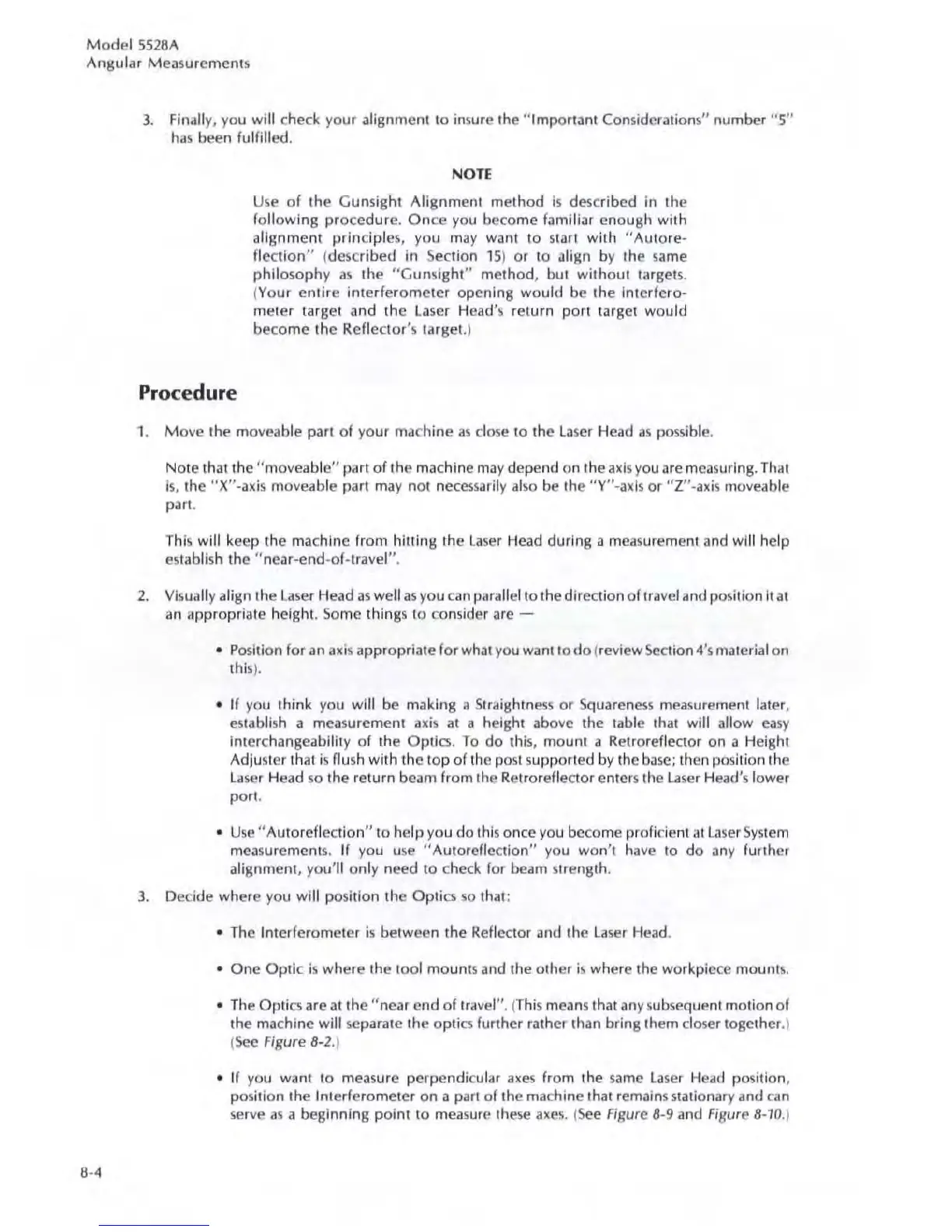Mod
el
5528A
Angular
Measurements
8·4
3. Finally, you
will
check y
our
alignment to
in
sure the ';Important Cons
id
erations" number "5"
has
been
fulfilled.
Procedure
NOTE
Use
of
the
Gun
sight Alignment
method
is described
in
the
following
procedure.
On
ce you
become
familiar
enough
with
alignment principles, you
may
want to start with
"Autore
-
flection" (
described
in Section
15
) or to align by
the
same
philosophy as the "
Gun
sight" method, but without target
s.
(Your
entire
interferometer
opening would
be
the
inlcrfero-
meter
target
and
the
laser
Head's return port target would
become
the Reflector's targeL)
1. Move the
moveable part
of
your
ma
chine
as
dose
to
the
laser Head
as
possible.
Note
that the "moveable" part of the machine
may
depend
on the
axi
s you are measuring. That
I
s,
the "
X"
-
axi
s moveable part may not necess
aril
y also be the "Y"-
aKi
s
or
"Z"-
aKi
s moveable
part.
This
wi
ll
keep
the
machine from hilling
the
laser Head during a measurement and
will
help
establish
the "near-
end
-of-travel".
2.
Vi
sually align the
laser
Head as well
as
you can parallel to the direction of travel and position
it
at
an appropriate height. Some things to consider are -
• Position for an
aKis
app
ropriate for what you
wanltodo
(review Section 4
'5
ma
terial on
this).
• If you think you
will
be making II Straightness
or
Squareness measurement
lat
er,
establish
a measurement
axis
al
a height
abo
ve the table that
will
allow ea
sy
inlerchangeabilily of the Optics.
To
do
this, mount a RelrorefieClor on a Height
Adjuster that
is
flu
sh with Ihe
top
of
th
e post supported
by
the base; then position the
la
s
er
Head so
the
return beam from the Retroreflector enlers the laser Head's lower
port.
•
Use " Autoreflcction" to help you do
thi
s
once
you become proficient
at
la
s
er
System
measurements.
If
you use
II
AutorcflCClion" you won't have to
do
any further
alignment,
you'
ll
only
need
to check for beam strength.
3.
Decide where you
will
position the Opti
cs
so ,hal:
• The Interferometer
is
between
the
Reflector and the
la
ser Head.
•
One
Optic is where the tool mounts and the
other
is
where the workpiece mount
s.
• The Optics are at the
"ncar
end
of
tra
v
el
". (
Thi
s means Ihal any subsequent motion of
Ihe
ma
chine
will
s
eparate
the optics further rather than bring them
doser
together
.)
(See Figure 8-2.)
•
If
you want to measure perpendicular axes from the same
la
ser Head position,
po
sition the Interferometer on a part of the machine that remains stationary and can
serve as a beginning
poinll
o meas
ur
e these axes. (See Figure 8-9 and Fisure 8-10.)

